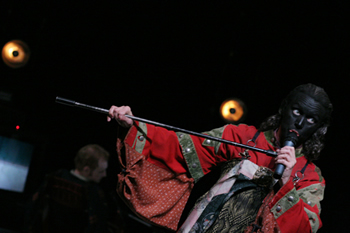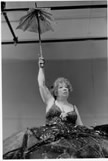
Emperors and Empresses
By Jonathan Kalb
Emperor Jones
By Eugene O'Neill
The Wooster Group
The Performing Garage
(closed)
Happy Days
By Samuel Beckett
Mabou Mines
P.S. 122
(closed)
Among the more amusing paradoxes of the
20th-century theater is classical avant-gardism--productions such
as Max Reinhardt's Turandot (1911), Peter Brook's A
Midsummer Night's Dream (1970), and Peter Stein's Peer
Gynt (1971) that acquired instant canonical stature despite
their boldly insolent dismissals of long cherished theatrical
traditions. Some would argue that their quick embrace proves that
the directors weren't truly avant-garde. But even those rebels
for whom marginalism is compulsory generally agree that these
directors were extraordinarily perceptive, not only about the
power of their innovations but also about how history and tradition
had blocked access to what was once dangerous and fervid in the
plays. The productions actually changed public perceptions about
the classic works and the range of expression available to the
theater.
The Wooster Group, one of America's premiere
avant-garde theaters, has long been led by a director (Elizabeth
LeCompte) so ambivalent toward advertizing and promotion that
she has sometimes seemed to hew to a principle of marginalism,
even as several members (Willem Dafoe, Spalding Gray, Ron Vawter)
pursued sparkling careers outside the ensemble. The Group's productions
change significantly after opening to the public, and they often
play in New York (typically to full houses of loyalists) without
opening to critics. Recently, however, The Wooster Group transferred
its production of O'Neill's The Hairy Ape to a commercial
run at the Selwyn Theater on 42nd St., and The Emperor Jones
(originally from 1993, last seen here in 1995) has now been opened
to review. Perhaps LeCompte has come round to the mortal hope
that some of her work will be recognized as classic. In any case,
The Emperor Jones deserves it.
Here is a classic play that is virtually
unperformable in 1990s America in the manner the author envisioned
in 1920. An expressionistic station-drama with realistic first
and last scenes, it depicts the quasi-mythical final night of
Brutus Jones, a black Pullman porter who establishes himself as
an exploitative emperor on a West Indian island after committing
several murders in the United States and escaping from a chain
gang. The Emperor Jones is famous for providing the first
serious and substantial role for an African American and for overcoming
international skepticism about the literary merit of American
drama.
Unfortunately, performed today as written
(that is, with earnest and realistic emotion by a black actor),
the cunning yet superstitious and uneducated Jones too easily
comes off as a racist stereotype ("I ain't 'lowin' nary body to
touch dis baby. She's my rabbit's foot"). Moreover, the hallucinatory
journey he takes through "the Great Forest"--after the natives
wise up to his stealing, he flees and gradually reverts to a primitive
state before dying--also too easily reads as racist because it
depends on dated and trite symbols of Jones's fear, guilt, and
ethnic past (drums, an alligator, and a witch doctor, for instance).
LeCompte's solution was to pare the action
down to its powerful core--Jones's inner journey of self-destructive
self- discovery--and then reconstruct its outer trappings using
theatrical means that haven't grown stale yet. Hence, Jones is
now played by a white woman in blackface (Kate Valk). Smithers,
the Cockney trader who half admires, half despises Jones, is played
by a white man whose face is famously menacing (Willem Dafoe).
And both are dressed in soiled Kabuki robes and move with oriental
formality. These are the only actors, apart from a stagehand in
street clothes (Dave Shelley) who dashes about and occasionally
joins the classical Japanese-style dancing. LeCompte has transformed
O'Neill's multi-character, panoramic epic into a two-character
chamber work, with the effect of streamlining its difficult questions
of race and identity.
Anyone who has ever wondered what Brecht
meant by "alienation" ought to see this production, with its cross-gender
casting, blackface, interculturalism, and physical movement all
working to encourage clear thought by making familiar questions
seem unfamiliar, imposing carefully chosen sources of strangeness
on the dialogue and action. During the first scene, for instance,
Valk sits downstage in a fur-lined roll-stool on the plain white
central platform, speaking into a mic attached to a rod she wields
like a scepter, the unblemished powder-black surface of her face
becoming a pictorial reference to regality that is belied
by her crude and cynical speech. Meanwhile, Dafoe sits upstage
of the platform, half out of sight, looking fixedly off to one
side and never at Valk while "conversing" with her in mocking
Cockney tones and sometimes riding herd over her lines.
The point is: all easy antinomies of blackness
and whiteness, majesty and tawdriness, boldness and servility,
insider and outsider, are placed in figural quotation marks on
this stage. And that is fundamentally what O'Neill intended, I
think, in setting up an uncultivated black as an emperor and a
disenfranchised white as his aggressive yet servile foil. LeCompte
has merely found means to let us see this for ourselves again,
restoring theatrical life to what was occluded by antiquated style
and language.
Smithers's and Jones's differences are
obvious, but LeCompte saw that their profound affinities were
the key to the play's contemporaneity. Both have platforms from
which to express arrogance (political position and skin color),
and both are determined to press their non-advantages. Condescension
and insincerity therefore amount to sources of comaraderie between
them--a sort of mutual backhanded acknowledgement of the void
beneath the social "face." This Smithers and Jones are never really
separated during the latter's forest journey. As she prepares
to leave, they join together in a precise parallel dance (an Americanized
blend of Kyogen, Noh and Kabuki performed to a rock beat), after
which Smithers affectionately smacks her with a fly swatter.
The only material hints of forest in this
setting (designed by Jim Clayburgh) are a few bent wires resembling
vines tied to a pole and several leafy plants to the rear of the
platform. Wide banks of fluorescent lights, electronic equipment
with operators in full view, and three video monitors constantly
playing upstage help generate the reluctantly technocentric atmosphere
that has long made The Wooster Group past master at conveying
themes of loneliness. Here, the monitor images are especially
crucial because they resolve the problem of O'Neill's pathos,
which is cloying when played as part of the live action. Grainy
location shots show Jones's visions (speeding trains, a prisoner's
striped pants), but more often Jones's and Smithers's faces, live
and recorded, are shown in various states of distortion (unfocus,
split-screen, reverse contrast, color fading to black and white).
For one thing, these images are beautiful in themselves, and for
another (since TV has become the Great Validator), they drive
home the ephemerality of Jones's celebrity and the tenuous hold
both characters always had on enfranchisement.
Not one moment of this production strikes
me as gratuitous or unduly extravagant. Recognizing the triteness
of the steadily increasing drumbeat in the original script, for
instance, LeCompte wisely inserted silences and unpredictable
rhythms. Understanding that the play was built around the melodramatic
suspense of a countdown of bullets, she undermined that effect,
upstaging the gunshots with wound-like pulsations on the monitors
and having Valk cross nonchalantly to display her death wound,
then walk off. Valk and Dafoe's sharply contrasting voices and
demeanors were also blended with musical care and precision, with
the humor of the thug-like Dafoe presented as a nimble oriental
adding pivotal lightness to the heavy, brooding action. Avant-
gardism aside, this is simply the shrewdest and most powerful
production of The Emperor Jones that any of us is likely
to see.
 Would
that the venerable Mabou Mines had done as well with Happy
Days, Samuel Beckett's 1961 classic about a woman buried
in a mound up to her waist during one act, then up to her neck
in the next. Beckett has been the impetus for some of Mabou Mines's
proudest work over the years, and it's hardly surprising that
the group's grand dame, Ruth Maleczech, would want to attempt
Winnie. The role isn't really right for her, though, and this
production (directed by Robert Woodruff) also features a stunning
set that isn't really right for the play.
Would
that the venerable Mabou Mines had done as well with Happy
Days, Samuel Beckett's 1961 classic about a woman buried
in a mound up to her waist during one act, then up to her neck
in the next. Beckett has been the impetus for some of Mabou Mines's
proudest work over the years, and it's hardly surprising that
the group's grand dame, Ruth Maleczech, would want to attempt
Winnie. The role isn't really right for her, though, and this
production (directed by Robert Woodruff) also features a stunning
set that isn't really right for the play.
As if reacting against the elegant Winnies
of the past (Madeleine Renaud, Billie Whitelaw), and the respectably
ordinary Winnies as well (Ruth White, Irene Worth), Maleczech
plays the part as a sloppy, old, fat actress (or whore) who wears
too much makeup and a ridiculously slinky bustier. All the famous
lines she half-remembers seem to come from bad plays she either
acted in or wishes she had, and her utter lack of refinement makes
it unthinkable that she ever read what Winnie is really quoting
(which includes Milton, Shakespeare, Browning and The Rubayyat
of Omar Khayyam).
Worse, rather than the mound of scorched
earth Beckett specified, set designer Douglas Stein has constructed
a spectacular pile of shattered car windshields, marvelous to
behold but deeply disappointing to contemplate. Its implication
is that the problem in the play is a matter of human agency--
technology and the throw-away society--rather than an inborn burden
to do with the naked fact of earthly existence. Let's chaulk this
one up to West Coast glitz (La Jolla Playhouse co- produced) and
hope that next time everyone involved will, as Beckett once wrote,
"fail again, fail better."
